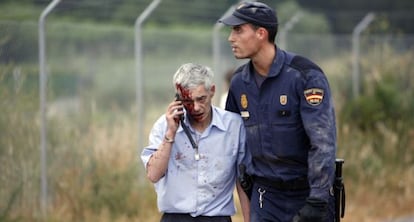The life of a disgraced train driver
Francisco Garzón stopped eating after the crash and now spends his time caring for his mother

To this day, there are still passengers on the Madrid-Ferrol Alvia line who write messages of support for Francisco Garzón on their train tickets and ask conductors to relay them to the disgraced driver. The notes are taken to him by a small group of close friends who take Garzón out to lunch every two weeks or so, to make sure he gets out of the house.
People no longer want to lynch Garzón, as they did the day after the crash. The attitude of the first investigating judge, Luis Aláez, who sought responsibility in higher places, played a role. His friends say that these days, the slight-framed Garzón, who blamed himself from the beginning, no longer hides at home, where he takes care of his ailing mother as he did before the tragedy (that is why he asked for a transfer to Galicia, despite being originally stationed in Madrid).
“He never changed his image to avoid being recognized,” says one of his closest colleagues. “Someone else would have dyed their hair.”
“I failed,” the driver is often heard to say, as he has done from the beginning without seeking to lay the blame on anyone else. He was not sent to preventive prison, and his train driver’s permit was suspended for just six months. But Garzón has not stepped on a train since the day of the crash, and will never drive one again.
He never changed his image to avoid being recognized. Someone else would have dyed their hair”
“He may go back to work, but Renfe will never let him be in charge of the machines,” said a colleague. “He will do office work. It will be very tough for him, because he is in love with trains.”
Antonio Martín Marugán, the conductor who phoned Garzón moments before the accident, will not be going back to work, either, since he applied for early retirement. On the day of the crash, he called Garzón to find out which platform the driver would stop at in Pontedeume, to ensure that a family who had to get off there would not have to cross the tracks with their luggage. Instead, two members of that family died in the crash, alongside all the other victims.
Marugán, 62, who lives just 1.5 kilometers from Garzón, does not have too many supporters. Many people are angry at the fact that he appeared on television to talk about the crash.
The driver, whom every single colleague has defined as “a very good man,” still goes to see the psychologist. “We think he is no longer taking the medication they gave him at first. Besides those pills, the doctor gave him others, because he stopped eating. He must have lost 20 kilos. He probably weighed no more than 40,” said a colleague. “He is better now, but we are afraid he might have a relapse because of the anniversary.”
All of them have put themselves in his shoes, and occasionally still “shed a tear.”
Tu suscripción se está usando en otro dispositivo
¿Quieres añadir otro usuario a tu suscripción?
Si continúas leyendo en este dispositivo, no se podrá leer en el otro.
FlechaTu suscripción se está usando en otro dispositivo y solo puedes acceder a EL PAÍS desde un dispositivo a la vez.
Si quieres compartir tu cuenta, cambia tu suscripción a la modalidad Premium, así podrás añadir otro usuario. Cada uno accederá con su propia cuenta de email, lo que os permitirá personalizar vuestra experiencia en EL PAÍS.
¿Tienes una suscripción de empresa? Accede aquí para contratar más cuentas.
En el caso de no saber quién está usando tu cuenta, te recomendamos cambiar tu contraseña aquí.
Si decides continuar compartiendo tu cuenta, este mensaje se mostrará en tu dispositivo y en el de la otra persona que está usando tu cuenta de forma indefinida, afectando a tu experiencia de lectura. Puedes consultar aquí los términos y condiciones de la suscripción digital.
Últimas noticias
The complicated life of Francesca Albanese: A rising figure in Italy but barred from every bank by Trump’s sanctions
From digital curfews to blocking apps: How technology experts protect their children online
Why the price of coffee has skyrocketed: from Brazilian plantations to specialty coffee houses
Confined to a Cuban hospital: When electricity is a matter of life or death
Most viewed
- Pablo Escobar’s hippos: A serious environmental problem, 40 years on
- Why we lost the habit of sleeping in two segments and how that changed our sense of time
- Trump’s obsession with putting his name on everything is unprecedented in the United States
- The Florida Keys tourist paradise is besieged by immigration agents: ‘We’ve never seen anything like this’
- Charles Dubouloz, mountaineering star, retires at 36 with a farewell tour inspired by Walter Bonatti








































